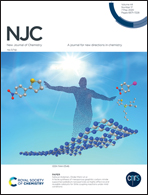Superior supercapacitive performance of grass-like CuO thin films deposited by liquid phase deposition†
Abstract
In the current study, cupric oxide (CuO) thin films have been deposited on stainless steel substrates (flat and mesh) by a binder-free liquid phase deposition method. The copper hydroxide thin films are deposited by means of a ligand-exchange equilibrium reaction of metal-fluoro complex ions, and fluoride ions are consumed in the reaction by boric acid as a scavenging agent. These films were annealed at 300, 400 and 500 °C to obtain CuO thin films. The films were characterized by different techniques in order to determine their phases, morphologies and wettability. The supercapacitive performance of the CuO films was found to be the best in a KOH electrolyte. The specific capacitance of the films was calculated from cyclic voltammetry (at several scan rates), charging–discharging (at different current densities) and electrochemical impedance spectroscopy. The highest values of specific capacitance at 3 mV s−1 in 6 M KOH electrolyte were 552 and 849 F g−1 on flat and mesh stainless steel, respectively. The supercapacitive performance was significantly improved when the CuO thin films were deposited on the mesh substrate compared to the flat substrate due to the higher surface area of the former. Also, a symmetric device with CuO on mesh stainless steel was fabricated and tested.



 Please wait while we load your content...
Please wait while we load your content...